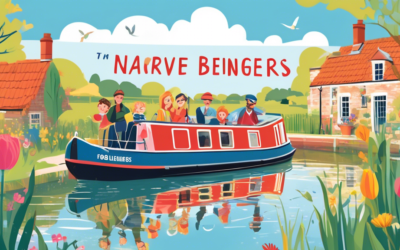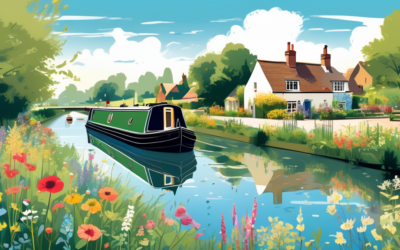Unveiling the Charm of Canal Bridges: A Journey Through Structure and Aesthetics
Canal bridges, those quaint and often overlooked feats of engineering, carry with them tales of yesteryear, ingenuity, and the ever-evolving landscape of our waterways. More than just passages over water, these bridges are testaments to the rich tapestry of history and culture, especially in the picturesque settings of the north west of England, where the Four Counties, Cheshire Ring, and Llangollen Canal cut through the heart of the countryside. Let’s embark on a journey to explore the architecture of canal bridges, uncovering their charm, function, and significance in connecting and enhancing the beauty of the region’s canal networks.
The Essence of Canal Bridge Architecture
Typically, canal bridges were built out of necessity, to allow for the passage of both people and livestock over the newly created waterways during the Industrial Revolution. However, these structures were not merely functional; they were meticulously designed to blend with the natural landscapes, reflecting the architectural styles and materials of their periods.
From the sturdy stone bridges of the Llangollen Canal to the iconic swing and lift bridges on the Cheshire Ring, the architecture of canal bridges varies widely. Each bridge tells a story, a memory of the era it was built in, often marked by a plaque or engraving indicating its construction year and sometimes the name of the engineer behind its design.
Types of Canal Bridges
Fixed Bridges
The most common type found along the canals, fixed bridges, are usually constructed from local stone or brick. An excellent example of this can be seen on the Llangollen Canal, where the Pontcysyllte Aqueduct, not a bridge but an aqueduct, performs a similar function at a much grander scale, carrying the canal over the valley of the River Dee. These structures often feature beautiful arches, a hallmark of the strength and durability of their design, capable of withstanding the test of time and the elements.
Swing Bridges
Swing bridges add a dynamic element to the canal experience. These bridges pivot horizontally around a fixed point, allowing boats to pass and then returning to close for road or foot traffic. A fascinating aspect of swing bridges is their manual operation, which involves a simple yet efficient mechanism that has remained largely unchanged over centuries. The exploration of the Cheshire Ring offers several encounters with these charming structures, inviting travelers to momentarily step into the shoes of a bridge keeper.
Lift Bridges
Lift bridges, which elevate vertically to allow boats to pass underneath, are less common but equally intriguing. Powered by hydraulics or manually operated using counterweights, these bridges showcase the innovative engineering solutions employed to minimize the disruption of both water and road traffic. Their elegant simplicity and mechanical beauty make them a favorite among engineering enthusiasts and casual observers alike.
The Architectural Beauty and Challenges
The design of canal bridges often reflects the local architecture, using similar materials and stylistic features to blend seamlessly with the surrounding landscapes. In regions like the north west of England, where historical and natural beauty abounds, this harmonization is particularly evident. The stones used in the construction of many canal bridges in this area were often sourced locally, ensuring that each bridge not only served a practical purpose but also contributed to the aesthetic continuity of the landscape.
One of the significant challenges faced in the construction of these bridges was the need to balance functionality with aesthetic appeal. Engineers and architects worked closely together to create structures that were durable and efficient while also being pleasing to the eye. This often involved innovative design solutions, such as the graceful curves of arches that provided the necessary strength without sacrificing elegance.
Conservation and Continued Enjoyment
Today, the preservation of canal bridges is of paramount importance. These structures are not only functional pieces of the canal infrastructure but also historic artifacts that offer a glimpse into the past. Conservation efforts focus on maintaining the integrity of the bridges while also adapting them to modern needs, ensuring they can be enjoyed by future generations.
The experience of traveling along the canals of the north west of England, whether by boat or on foot, is greatly enriched by the presence of these architectural gems. Each bridge encountered tells a part of the story of the region’s industrial heritage, the evolution of engineering, and the timeless beauty of functional design.
As we explore these waterways, taking in the scenic beauty and tranquility, let’s also pay homage to the silent sentinels that stand guard over them. The canal bridges, in all their variety and splendor, are enduring symbols of human ingenuity and the desire to harmonize with the natural world. So next time you glide beneath an arch or crank the mechanism of a swing bridge, spare a thought for the legacy of design and endeavor that these structures represent. After all, they are not just crossings over water but bridges through time, connecting us to the rich narrative of our shared history and heritage.
In conclusion, the architecture of canal bridges is a fascinating subject that combines elements of engineering, design, history, and art. As we navigate the serene waters of the Four Counties, Cheshire Ring, and Llangollen Canal, let us appreciate the silent yet eloquent testimony of these bridges to the ingenuity and aesthetics of a bygone era. In doing so, we not only enrich our understanding of the past but also ensure that the beauty and significance of these structures are preserved for the enjoyment and inspiration of those who follow in our wake.
Fancy a boat holiday – Check out Floating Holidays fleet for hire!






0 Comments